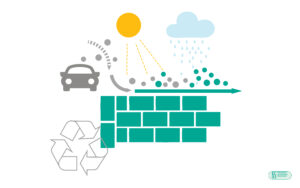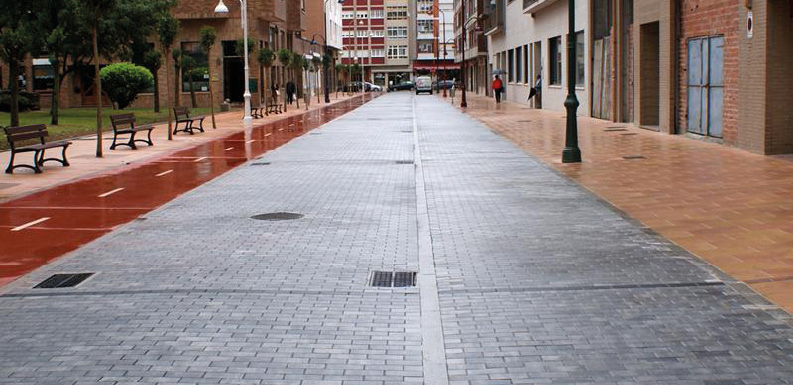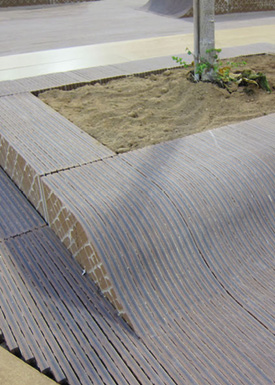EC03 HARD SURFACES MADE OF RECYCLED / DECONTAMINANT MATERIALS
Hard surfaces that reduce environmental impact

Aim
To foster the use of construction systems or products that contain recycled materials or material with decontaminating properties that contribute to circular economy tenets.
Why?
Using recycled materials in hard surfaces or urban furniture in construction products and systems or materials that counter pollution through photocatalysis reduces the environmental impact of works to be carried out.
The standard level of emissions of materials is given by conventional construction systems and, according to various studies, is between 600 and 750 kg CO2/m2. An improved low emissivity system should be capable of reducing emissions by 50 % by setting an average value of 300 kg CO2/m2.
How?
Compared to the standard level mentioned above, the improved level can be achieved by using systems based on renewable natural materials (such as wood) or by using only recycled and recyclable industrial materials. However, an optimised scenario of levels below 200 kg CO2/m2 can be achieved by adding the continuous management of resources throughout the entire life cycle of materials. Overall, the most important measures are as follows:
► From the outset of planning, consideration should be given to the life cycle of materials, encouraging the acceptance of new materials based on the CO2 embedded in them. Environmental databases and specifications of construction products should be considered in order to take into account the effect of emissions resulting from the transport and on-site use of materials. There are certifications accrediting the adequacy of materials to this goal such as the Cradle to Cradle certification or the AFNOR certification.
► Operational measures should be established to encourage using recycled or recyclable materials and using construction techniques that make it possible to recycle, dismantle and reuse waste, thus reducing the quantities transported to landfills. Local building materials (natural, renewable) should be used and high environmental impact materials that contribute to increased emissions should be avoided. The use of local gravel pits and reservoirs for on-site construction should be permitted, exclusively on a local basis, reducing the need for transport of stone materials.
► Reducing emissions from the design of the building configuration or development is also possible. For example, the decision not to build basements results in a reduction in emissions because of what this means in the overall weight of the energy demand for the construction process.
In some Dutch cities, bicycle lanes have been paved with materials aligned with this strategy: composites consisting of wood fibres and natural resin, concrete without cement, recycled paper, recycled glass, etc.
There are also materials on the market such as paving materials made from high-strength concrete which, in addition to fulfilling their architectural function, actively contribute to the elimination of pollutants from the atmosphere by means of a process similar to the chemical process carried out by plants. These convert harmful gases into compounds that are harmless to health and the environment by means of a natural oxidation process that is free of chemical agents and has an inexhaustible effect over time. It is very effective in removing nitrogen oxides (NOx), volatile organic compounds (VOCs) and particulate matter (PM). They are manufactured, among others, with materials coming from recycling, especially from the construction and industrial sectors. Paving the surface equivalent to a football field with decontaminating products would degrade as much NOx as that produced by 4,000 cars in a year.
This criterion can be applied to other construction systems, besides hard surfaces, and can be included in instructions or ordinances. For example, in the technical instruction for the application of sustainability criteria in the works and projects of the Barcelona City Council, criteria supporting the circular economy are defined for the drafting of public space and infrastructure projects. The contracting authority may establish environmental criteria relating to construction products and materials in the tender documents for the drafting of development projects, such as, for example:
• using aggregates and other construction materials incorporating a percentage of recycled material;
• using photo-catalytic building materials to reduce NOx in the air;
• using construction materials, such as horizontal signalling materials, which meet the criteria laid down in one of the type I eco-labels;
• excluding surface treatments or phytosanitary treatments with a high environmental or health impact;
• valuing grey energy from building materials included in the ITEC BEDEC database; and
• using criteria related to durability and maintenance, including selecting materials on the basis of use, appropriate sizing or reusability.
The LIFE CERSUDS project proposes an innovative permeable ceramic paving that has its origins in the framework of an R&D project financed by the Regional Government of Valencia in 2010: Reutilización y reciclado de productos obsoletos o deshechos de fabricación para la generación de nuevos productos. Permeable paving relies on the use of ceramic tiles of low commercial value. The system concept consists of cutting the ceramic tiles into strips with a specific width, which are then grouped together to form permeable ceramic modules. The development of these modules offers speed and simplicity in the laying of hard surfaces. http://www.lifecersuds.eu/es LIFE CERSUDS is financed by the LIFE 2014-2020 Environment and Climate Action Programme of the European Union with reference LIFE15 CCA/ES/000091.
The Grupo Integrado de Ingeniería Civil y Geomática (Giceo), belonging to the Escola Politécnica Superior de Enxeñaría de Lugo studies the application of co-products resulting from the use of eucalyptus wood in the panel industry for civil engineering applications, such as road and railway construction, in the bituminous mixture used in the rolling layer of roads.
The most ambitious scenario is the Cradle to Cradle certification, which is based on the idea contained in the book Remaking the Way We Make Things published in 2002 by Michael Braungart and William McDonough, which proposes a new way of interpreting environmentalism. Traditionally, the main slogan of environmentalism has been to reduce, reuse and recycle. The authors suggest a new approach: reducing the impact on the environment would lead to a slowdown, but, sooner or later, we would be coming to the same end.
They suggest tackling problems at their root: from the very outset of the design phase and conception of any product; strategies or policies must take into account all the phases of the products in such a way that not even energy costs are necessary and that even the balance of expenses and contributions is positive. In the planet’s ecosystems, there is no such thing as waste. The aim would be to design all products in such a way that the materials are recycled for the same use or are recycled upwards, i.e. that the next use has more value than the current one.

Decontaminant hard surfaces. Calle El Acebo, en Piedras Blancas, Asturias. Source: http://numaco.blogspot.com

Recycled hard surfaces. LIFE CERSUDS
street SCALE INTERVENTION

ISSUES AFFECTED
SUITABLE FOR COMBINING WITH OTHER SOLUTIONS
measuring elements
Indicator
(I1) NOx reduction for decontaminating hard surfaces
(I2) % of decontaminant / recycled hard surfaces
Unit
(I1) gr/m2
(I2) %
Minimum goal
341 gr/m2/year
Recommendation
50 % of the surface paved with decontaminating materials and more than 30 % of their composition obtained from recycled materials.
Desirable goal
683 gr/m2·year.
Recommendation
80 % of the surface paved with decontaminating materials and more than 50 % of their composition obtained from recycled materials.
Measure method / Formula
Surface measurement.
Degraded ΔNOx = A x B
A: % of paved surface on which decontaminating elements are laid
B: degradation rate of NOx/m2/year
(to find out B, consult the gr/m2/hour specification of the product).
PLANNING LEVEL
Urban development project
Building project
AGENTS INVOLVED
Local Officials
Planning and design team
WHAT SHOULD BE CONSIDERED FOR ITS IMPLEMENTATION?
The choice of this type of materials does not usually condition conventional construction processes.
POSIBLE ACTIONS DEVELOPED BY THE ADMINISTRATION:
• A regulatory proposal incorporating articles relating to the consideration of the life cycle of materials should be made.
















